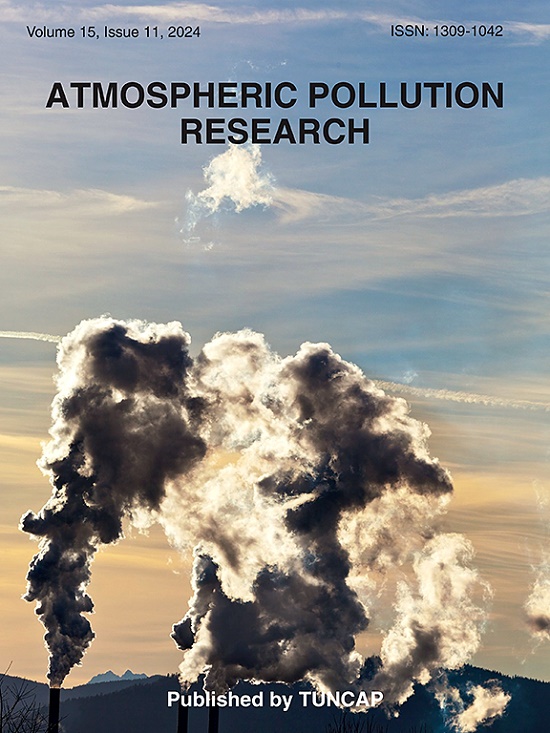塔尔沙漠附近两次强沙尘暴期间大气粒子的物理化学特征
IF 3.5
3区 环境科学与生态学
Q2 ENVIRONMENTAL SCIENCES
引用次数: 0
摘要
颗粒物(PM5;空气动力直径≤5 μm)采集于印度拉贾斯坦邦Thar沙漠附近Jhunjhunu地区(28°80′n, 75°24′e)。样品采集是在两个强烈的沙尘暴条件下进行的,即2022年5月4日的DS-1和2022年5月6日的DS-2。采用x射线衍射(XRD)、x射线荧光光谱(XRF)和扫描电子显微镜(SEM-EDS)对ds事件发生前、发生中和发生后收集的粉尘颗粒的物理化学性质进行了研究。粒子的AR(纵横比)频率分布在>;1.6 ~ 1.8和>;DS-1为2.00-2.20,DS-2为1.6-1.8,峰为单峰,说明大部分颗粒高度非球形。基于XRF对粉尘颗粒的体成分分析,观察到不同元素的氧化物,其顺序为SiO2>;Al2O3>CaCO3>分别比;Fe2O3>Cr2O3在两次风暴中。赤铁矿(Fe2O3)在可见光和近紫外波段具有较高的吸收电位,分别从1.47% (DS-1)增加到6.14% (DS-1)和5.43% (DS-2)。在可见光范围内(0.38 ~ 0.68 μm), DS-1和DS-2的折射率虚部k值分别从0.004和0.003上升到0.048和0.045。本研究可减少塔尔沙漠地区矿物粉尘辐射收支估算的不确定性。本文章由计算机程序翻译,如有差异,请以英文原文为准。

Physico-chemical characterization of atmospheric particles during two intense dust storms in the vicinity of Thar Desert
Particulate Matter (PM5; aerodynamic diameter ≤5 μm) was collected over the Jhunjhunu region (28°80′N, 75°24′E) in the neighborhood of the Thar Desert, Rajasthan, India. Sample collection was done during two intense Dust Storm (DS) conditions i.e., DS-1 on May 4, 2022 and DS-2 on May 6, 2022. The physico-chemical properties of dust particles collected pre-, during, and post-DS events were studied using X-ray diffraction (XRD), X-ray Fluorescence Spectroscopy (XRF), and Scanning Electron Microscope coupled with Energy Dispersive X-ray Spectroscopy (SEM-EDS). The frequency distribution of AR (Aspect Ratio) of particles shows bimodal peaks in the bin range >1.6–1.8 and > 2.00–2.20 during DS-1 and monomodal peak at >1.6–1.8 during DS-2, indicating most of the particles are highly non-spherical. Based on bulk compositional analysis of dust particles obtained using XRF, oxides of different elements were observed in the order of SiO2> Al2O3> CaCO3>MgO > Fe2O3> Cr2O3 during both storms. Hematite (Fe2O3) which has high absorption potential in visible and near UV Wavelength is found to increase from 1.47 % (pre-DS) to 6.14 % (DS-1) and 5.43 % (DS-2), respectively. For the visible range spectrum (0.38–0.68 μm), it is discovered that the imaginary part of the refractive index (k) value rises from 0.004 to 0.048 during DS-1 and from 0.003 to 0.045 during DS-2. The present work could reduce the uncertainty in the radiation budget estimations of mineral dust over the Thar Desert region.
求助全文
通过发布文献求助,成功后即可免费获取论文全文。
去求助
来源期刊

Atmospheric Pollution Research
ENVIRONMENTAL SCIENCES-
CiteScore
8.30
自引率
6.70%
发文量
256
审稿时长
36 days
期刊介绍:
Atmospheric Pollution Research (APR) is an international journal designed for the publication of articles on air pollution. Papers should present novel experimental results, theory and modeling of air pollution on local, regional, or global scales. Areas covered are research on inorganic, organic, and persistent organic air pollutants, air quality monitoring, air quality management, atmospheric dispersion and transport, air-surface (soil, water, and vegetation) exchange of pollutants, dry and wet deposition, indoor air quality, exposure assessment, health effects, satellite measurements, natural emissions, atmospheric chemistry, greenhouse gases, and effects on climate change.
 求助内容:
求助内容: 应助结果提醒方式:
应助结果提醒方式:


